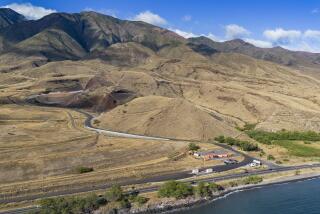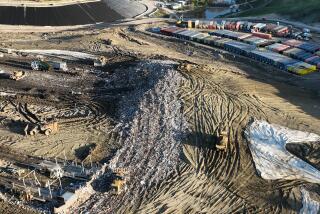Soil at Santa Clarita Tract on Porous Side : 2 Sites Short of Ideal for Toxic Dumping
The soil at two proposed sites for a county toxic-waste dump, including one in the Santa Clarita Valley, is too porous to be ideal for such a dump, but that does not rule out continued consideration of the sites, engineers said Friday.
Preliminary core sampling of the earth up to 100 feet below ground level at the privately owned sites--one near Gorman and the other in the Valencia area--found soil that âby itself is not tight enough, or impermeable enough, to qualify,â said Kieran Bergin, a county sanitation district engineer who is heading the search for a dump location.
However, he said, the sites might be made suitable if the underground repository is sealed with two feet of compacted clay plus a plastic liner.
Ideal Site Needs Liner Too
Because of the complicated and changing nature of federal and state regulations for such sites, even an ideal geological formation, such as naturally dense clay, unbroken granite or volcanic rock, probably would have to be lined with clay and plastic anyway, he said, so the porous soil alone will not rule out the two sites.
However, he said, with a less permeable natural foundation for the dump, âweâd at least have the comfort of knowing that the underlying geology was very tight and would permit fluids to move only very slowly.â
The harder and less permeable the soil under such a dump, the less likely it is that toxic materials can leak into the ground-water supply.
The two sites are among four being considered for the dump, which would receive the dry residue of hazardous wastes after processing at treatment plants to remove liquids. The county is also searching for sites for the treatment plants.
Protests Over All Sites
Neighbors and the landowners or users of all four proposed sites have protested the possibility of the land being designated a toxic-waste dump.
One of the two sites is on land owned by Newhall Land & Farming Co. in Potrero Canyon near Valencia, just south of California 126 about a mile east of the Los Angeles-Ventura county line.
The other is in Oso Canyon on the Tejon Ranch, about five miles east of Gorman.
Also under consideration are a site on the countyâs 320-acre Butte Valley Wildflower Sanctuary near Hi Vista in the Mojave Desert and another on the southern rim of Rosamond Dry Lake on Edwards Air Force Base.
The Air Force has refused to discuss use of the Edwards Air Force Base location and will not allow county geological inspectors on the site. An appeal by county officials to Defense Secretary Caspar Weinberger was rejected, Bergin said, but the site has been kept on the list of possibilities, ânot that we have much chance of getting in there, but just in case they change their minds.â
14 Days for Soil Tests
The county secured a court order in February requiring the owners of the two private sites, in Oso and Potrero canyons, to allow county geologists onto their property for 14 working days to conduct soil tests.
The underlying soil at the wildflower sanctuary was the most suitable for the dump, Bergin said. The core samples drilled from 30 to 70 feet beneath the surface âlooked like concrete night sticks,â he said. âIt appears to have the natural characteristics we want, whereas the other sites would need an engineered liner.â
However, he said, that does not necessarily make the wildflower site the leading candidate. âWe still have to take into account other factors--such as transportation and the present use of the land. All of this leaves us in the position of comparing all four sites against each other.â
Could Take 5 Years
He said he plans to submit a report to the Board of Supervisors before the end of the year. Selection of any site by the supervisors will trigger more extensive testing, including more thorough soil tests, and will be just the beginning of a lengthy process before a dump can be built or opened. More detailed testing and completion of environmental reports and other legal requirements will take five years before the state and federal governments give an answer to a request for final construction permits, âwhich may indeed then be âno,â â he said.
Until November of 1984, hazardous chemical wastes were buried at the privately owned BKK landfill in West Covina, but it was closed because of ground-water contamination and the production of explosive fumes that leaked into homes near the site.
Since then, hazardous wastes have been trucked to the Kettleman Hills dump in Kings County and the Casmalia dump in Santa Barbara County, âboth of them about 200 miles from central Los Angeles,â Bergin said. âSome of it gets trucked as far away as Texas.â
The county still has the option of trying to convince some other countyâs government to allow construction of a dump elsewhere for Los Angeles, Bergin said, âbut the other counties are not particularly anxious to become Los Angeles Countyâs dumping ground.â
More to Read
Sign up for Essential California
The most important California stories and recommendations in your inbox every morning.
You may occasionally receive promotional content from the Los Angeles Times.










